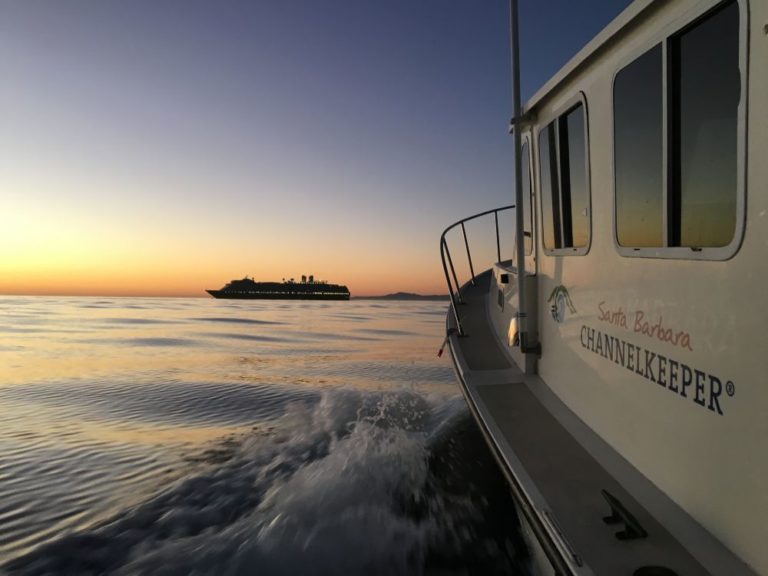Seventeen cruise ships are scheduled to visit Santa Barbara between March and April this year. With the exception of one, all of them have grades of D or F for water quality impacts, according to Friends of the Earth’s Cruise Ship Monitoring Report Card. Three of the visiting ships receive “F” grades for air pollution. Two of the visiting cruise ship lines committed criminal violations of environmental laws between 2017 to 2021.
Prompted by concerns such as these, Santa Barbara Channelkeeper’s cruise ship monitoring program has relaunched and will engage a select number of cruise ships as they arrive in our area. By communicating with captains upon arrival, the organization’s cruise ship monitoring program aims to safeguard the coastal environment and provide accountability through watchful presence.
Cruise ships generate enormous volumes of waste. A typical cruise ship generates 30,000 gallons of sewage, 250,000 gallons of greywater (wastewater from galleys, showers, sinks, and laundry), 5,000 gallons of oily bilge water, 15 gallons of toxic chemicals, and seven tons of solid waste, as well as air pollution equal to that of 12,000 cars—every day.
The City of Santa Barbara asks that captains make a voluntary commitment to refrain from using incinerators and discharging sewage or greywater within 12 miles of Santa Barbara Harbor. However, monitoring compliance with these agreements relies largely on good faith that the captains and crew will abide by these commitments. Channelkeeper’s cruise ship monitoring program attempts to address monitoring gaps by providing additional vigilance.
As ships enter the 12-mile, voluntary no-discharge zone, Channelkeeper staff, aboard the organization’s 31-foot vessel, hail the captain via marine radio to remind the crew of the no-discharge commitment and to let them know that Channelkeeper will monitor for discharges during the ship’s time in the Santa Barbara Channel.
“The cruise ship captains are generally polite, though surprised, to encounter our team out in the Channel,” says Channelkeeper’s Science and Policy Director, Benjamin Pitterle. “It’s clear that they aren’t used to being monitored in most of the places that they travel.”
Channelkeeper recently proposed that the City of Santa Barbara also consider adopting an additional vessel speed reduction requirement as part of the voluntary commitments to lower the risk of ship strikes for whales in our channel.
From November to May, approximately 19,000 gray whales migrate along the South Coast. In addition, the abundance of krill in the Santa Barbara Channel provides feeding grounds for the largest blue whale population in the world and attracts high densities of several endangered baleen whale species, including humpback and fin whales. These sensitive marine mammals are vulnerable to ship strikes.
Vessel speed reduction requirements are an effective way to decrease propulsion engine emissions and fuel consumption. The organization believes that an additional vessel speed reduction requirement could help reduce the risk of ship strikes for whales in our channel while also lowering harmful greenhouse gas emissions produced by cruise ships. This recommendation is aligned with current regulations implemented by the Channel Islands National Marine Sanctuary and Santa Barbara County Air Pollution Control District. Channelkeeper also suggested that the City establish a committee to evaluate public opinion of its cruise ship program, especially related to climate change goals.
“We look forward to working with City leaders to identify and help develop solutions that help us reach goals related to climate change and keep our environment, economy, and community healthy,” said Channelkeeper’s Executive Director, Ted Morton.
In the meantime, Channelkeeper staff will continue to monitor cruise ships via regular marine patrols as part of the organization’s ongoing work to help protect water and air quality in the Santa Barbara Channel.
About Santa Barbara Channelkeeper
Santa Barbara Channelkeeper was founded in 1999 as a program of the Environmental Defense Center and became an independent 501(c)(3) non-profit organization in 2001. For more than 20 years, the organization has worked to protect water quality, restore aquatic ecosystems, advocate for clean water, enforce environmental laws, and educate and engage citizens in implementing solutions to water pollution and aquatic habitat degradation.


Leave a Response